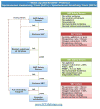The ABCDEF Bundle in Critical Care
- PMID: 28284292
- PMCID: PMC5351776
- DOI: 10.1016/j.ccc.2016.12.005
The ABCDEF Bundle in Critical Care
Abstract
The ABCDEF bundle represents an evidence-based guide for clinicians to approach the organizational changes needed for optimizing intensive care unit patient recovery and outcomes. This article reviews the core evidence and features behind the ABCDEF bundle. The bundle has individual components that are clearly defined, flexible to implement, and help empower multidisciplinary clinicians and families in the shared care of the critically ill. The ABCDEF bundle helps guide well-rounded patient care and optimal resource utilization resulting in more interactive intensive care unit patients with better controlled pain, who can safely participate in higher-order physical and cognitive activities at the earliest point in their critical illness.
Keywords: Analgesia; Delirium; Early mobility; Intensive care unit; Pain; Sedation; Spontaneous awakening trials; Spontaneous breathing trials.
Published by Elsevier Inc.
Figures








References
-
- Covinsky KE, Pierluissi E, Johnston CB. Hospitalization-associated disability: "She was probably able to ambulate, but I'm not sure". JAMA. 2011;306(16):1782–1793. - PubMed
Publication types
MeSH terms
Grants and funding
LinkOut - more resources
Full Text Sources
Other Literature Sources
Medical

